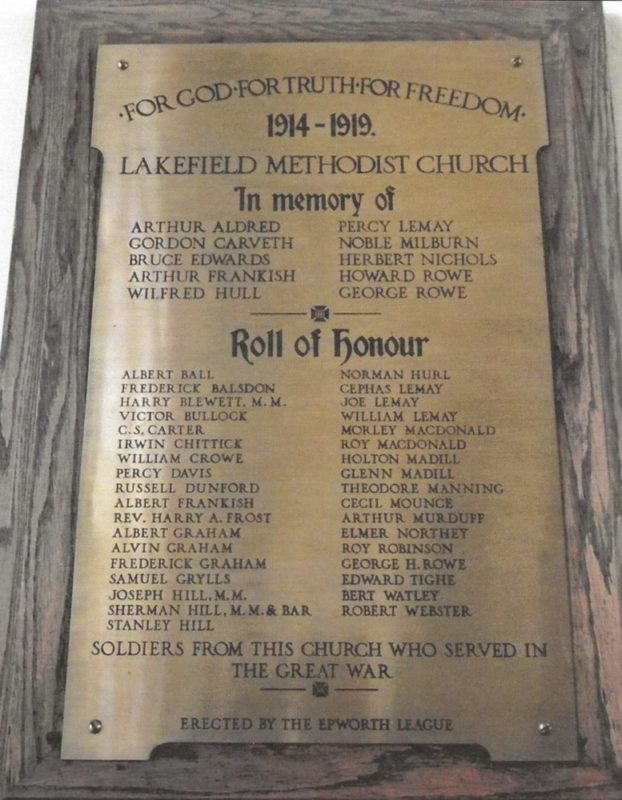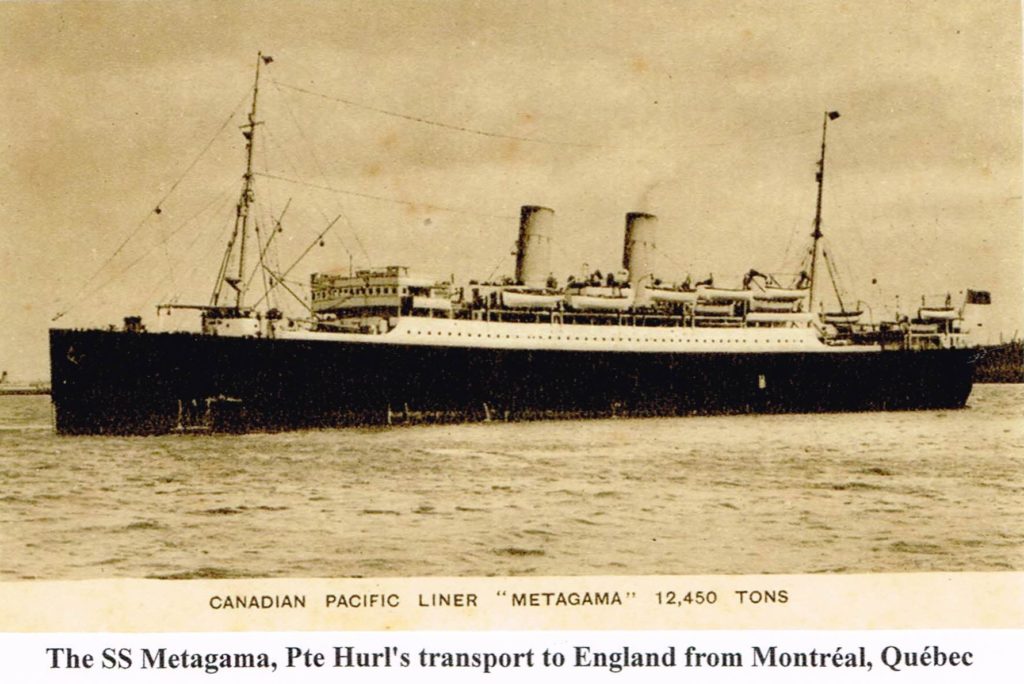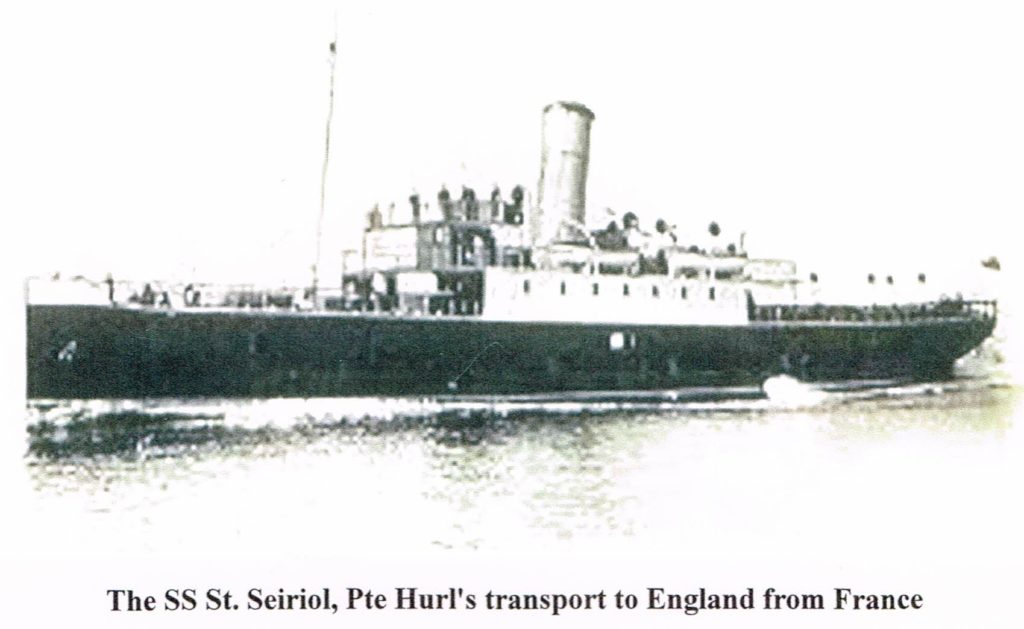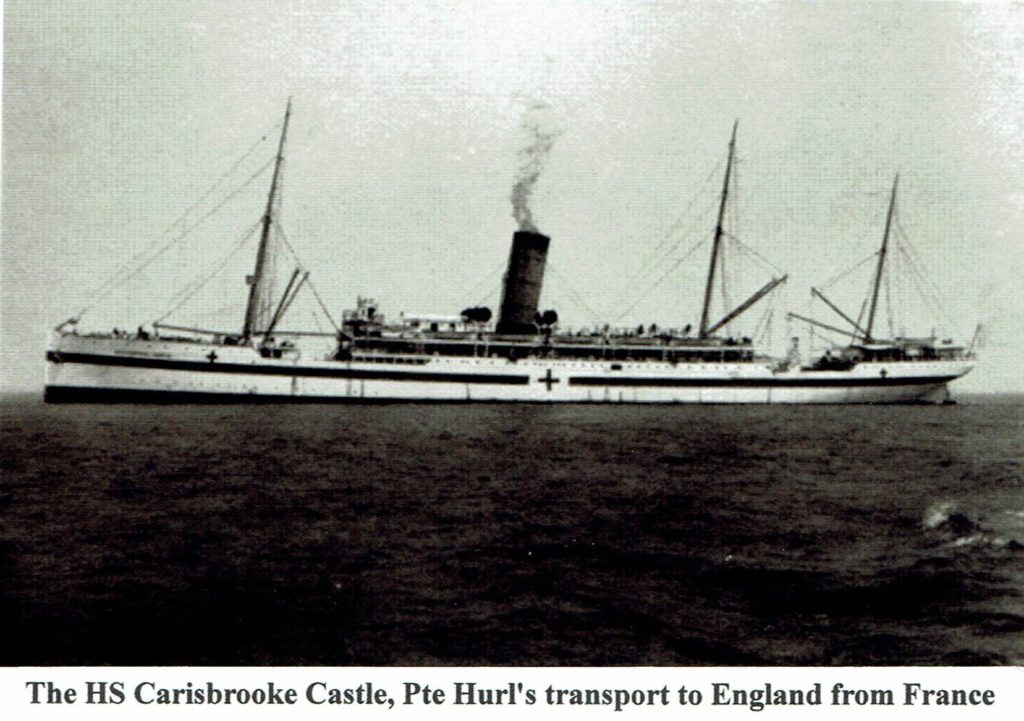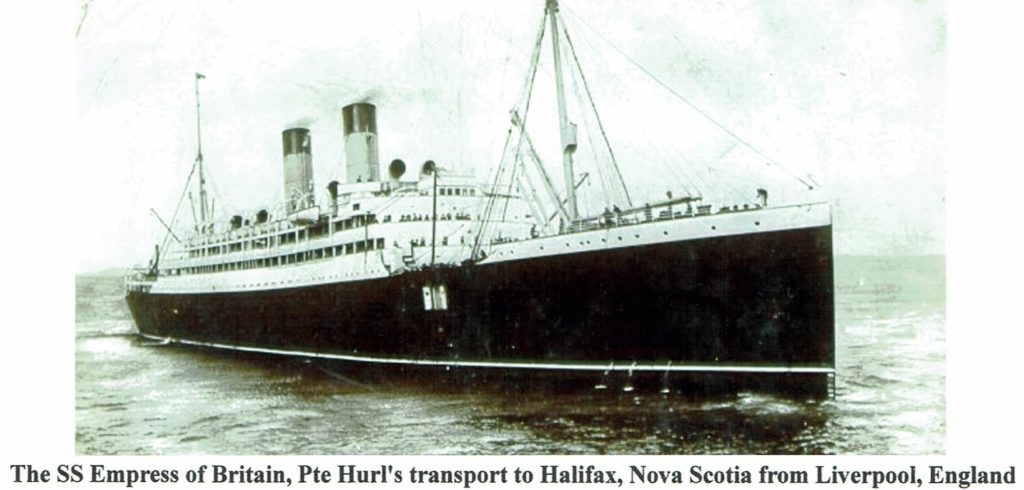MILITARY HISTORY
Private Norman Douglas Hurl – 59489 — ACTIVE SERVICE (World War I)
On November 18, 1914 Norman Douglas Hurl completed the Attestation Paper for the Canadian Army Canadian Expeditionary Force (CEF). He was 19 years, 4 months old when, as a single man, he enlisted for the duration of the War. Norman Douglas was born in Peterborough, Ontario and gave his birth-date as July 1, 1895. Norman Douglas indicated; that he did not presently belong to a Militia Force, but that he had 4 years Military experience with the ”Peterborough Battery”. There is nothing on his File to indicate where he was educated or to what level. As far as his Trade or Calling is concerned, he lists Labourer. Norman Douglas was 5′ 6” tall, with a 35” chest (expanded). There is no indication of his weight. He had a fair complexion with blue eyes and brown hair. His Medical Examination was completed November 18, 1914 in Kingston, Ontario. He had no medical issues or physical limitations and was deemed fit for Overseas duty with the CEF. His next-of-kin was listed as his father Mr. William J. Hurl of Lakefield, Ontario. Norman Douglas Hurl signed the Oath and Certificate of Attestation on November 18, 1914 in Kingston, Ontario. He was taken-on-strength with the 21st Battalion (Bn) as a Private (Pte) and was assigned Service Number 59489.
There is no reference in the File as to where Pte Hurl and the 21st Bn trained but based on the dates, it was more than likely Valcartier, Québec. Valcartier was erected as a Military Training Base in August 1914, as part of the mobilization of the Canadian Expeditionary Force at the outset of World War I. The Base was located approximately 16 miles north of Québec City. In the beginning the facilities and training were pretty rudimentary. Training consisted of marching, rifle, and bayonet drills. The Officers, among other things, practiced swordsmanship and use of a pistol. The main goal was to form the men in Units and ship them off to England, as quickly as possible, where they would complete their training.
Pte Hurl and the 21st Battalion disembarked at Devonport, England on May 15, 1915 and proceeded to West Sandling, near Hythe, in Kent County. There were no entries in the File from September 14, 1915 to November 18, 1916.
The War Diary of the 21st Canadian Infantry Battalion indicates the following for this period of time.
Pte Hurl and the 21st Bn embarked from Folkestone, England for France aboard the St. Seiriol, on September 14, 1915, but halfway across the English Channel they were turned back by Naval Authorities. They sailed the following morning arriving at Boulogne, France by midday, on the 15th.
The SS St. Seiriol, Pte Murduff’s transport to England from France
After a day’s halt at a Rest Camp they entrained for St. Omer. Departing from St. Omer, they marched to Raisbrooke where they rested before moving on to Eecke on the Sep 17th and then on to Dranoutre on the 18th. On the 19th, the 21st Bn took up positions in the Front-Line trenches, where they stayed until relieved on the 27th, moving to billets at Dranoutre. Oct 3rd, the Unit was back in the trenches. On the 9th, the Bn proceeded to billets at La Cylette. On Oct 27th, 1915 the Bn moved back to the trenches. On November 1st, the 21st Bn proceeded to billets at Ridgewood, where it stayed the night in Divisional Reserve. On the Nov 2nd, it moved to a Divisional Reserve position at La Cylette, where the 21st Bn stayed until the 7th. On the 8th, it was back to the Front-Line trenches, where they stayed until the 13th, when it moved to a Brigade Reserve position at Ridgewood. On the 18th, the Bn proceeded to the left Sub Section of the N and O trenches. On the 22nd, it moved back to La Cylette, where it stayed to the 26th, when it was back to the N and O trenches.
On November 27, 1915 Pte Hurl was sentenced to 5 days in Field Prison No 2 for being drunk.
When Pte Hurl was released, on December 2nd, the 21st Bn were in billets at La Clyette, where they remained until December 16th, when they moved forward to the N and O trenches. In general terms, the Line was quiet until the 19th, when the enemy fired a number of Gas Shells, into the general area. As a result of the prevailing winds carrying the fumes over the trenches of the 21st Bn many of the men suffered eye and throat troubles. On the 22nd, they were relieved and proceeded to a Brigade Reserve position at Ridgewood where they were engaged in work parties. The 25th, being Christmas Day, was a day of rest with no fatigue or work parties. ”Christmas was celebrated in a very quiet manner, with plenty of Xmas Puddings”. On the 28th, it was back to the N and O trenches, where the Bn stayed until January 3rd, 1916 when it proceeded to a Divisional Reserve position at La Clyette. From the 10th to 16th, the 21st Bn was back in the trenches, but everything was quiet. On the 16th, they proceeded back to a Brigade Reserve position at Ridgewood.
On January 20, 1916 Pte Hurl was ”sentenced to 28 days in Field Prison No 1 for Leaving his Post, whilst on Sentry Duty”. When he was released, the 21st Bn were in the N and O trenches. On February 28th, they were relieved and in Brigade Reserve at Ridgewood.
March 1916 – found the 21st Battalion either in the N and O trenches (where things were generally quiet), Brigade Reserve at Ridgewood, or Division Reserve at La Cylette.
April 1916 – began with the Bn in the N and O trenches. On the 5th, it proceeded to La Cylette, to B Camp on the 6th, and the Reserve trenches at Scottish Wood on the 7th. On the evening of April 8th, the 21st Bn moved to P trenches in preparation for an attack on ”The Craters”. On the 9th, it attacked and captured No 2 Crater suffering 29 casualties. From the 11th to the 20th, the 21st Bn was at B Camp. From the 20th to the 24th, the 21st Bn was moved to the centre of the 4th Brigade Front-Line trenches. On the 24th, it was relieved and moved to billets at Dickebusch, then B Camp.
May 1916 – while at B Camp the 21st Bn undertook; physical training, rifle and extended order drills. It also furnished, on a periodic basis, fatigue and working parties to the Reserve and Front-Line trenches. From the 9th to 13th, it was in Reserve at Scottish Wood. From the 13th to the 24th, it was in the Centre Sector of the 4th Brigade trenches. On the 24th, the 21st Bn was relieved and moved back to B Camp.
June 1916 – was a repeat of a series of moves to and from the Front-Line trenches and Reserve positions. During the time in the trenches the enemy Artillery and machine guns were fairly active resulting in a number of casualties. The month ended with the 21st Bn at Micmac Camp, which was the old A Camp.
July 1916 – opens with the Bn at Micmac Camp. On the 4th, it moved to Chippawa Camp (old B Camp) where it stayed until the 15th. During this time, they underwent the usual training regimen. One day, the Bn was entertained by the PPCLI Concert Band and participated in a Sports Day. From the 15th to the 23rd, it was back to the trenches, where things were fairly quiet. On the 23rd, it was relieved and moved back to Micmac Camp where it stayed until the end of the month.
August 1916 – begins with the 21st Bn in billets at Chippawa Camp, where they stayed until the 8th, going through the normal training routine. From the 8th to 15th, they were in the N and O trenches. They moved to Ridgewood, where they stayed from the 15th to the 24th. Now began a series of daily marches eventually taking the 21st Bn to Zouafques, France, in the Pas de Calais Region.
September 1916 – the 21st Bn is still in billets at Zouafques. Now begins a series of moves that eventually takes them to the area Brickfields. On the 14th, the Bn moves into the Front-Line trenches in preparation for an attack on the 15th. ”At Zero Hour – 6:20 AM, an Artillery barrage is laid down 50 yards in front of the enemy Front-Line. At 6:21, it lifted to the enemy Front-Line. At 6:24, lifted to 100 yards beyond the enemy Front-Line and the 21st Bn then advanced covered by heavy Machine Gun fire. No difficulty was experienced in taking the enemy Front-Line trenches. The advance now paused for mop-up. Continuing the advance to the next objective, the Bn suffered heavily by reason of enemy Machine Gun fire from the left flank. These Guns were eventually accounted for and the advance continued. On entering the area of the Sugar Refinery*, less opposition was experienced than anticipated, and 125 enemy prisoners were taken”. The Bn now consolidated its gains and remained in position until the 17th, when it was relieved, and returned to Brickfields, where it stayed until the end of the month. *The Battle of Courcelette on September 15, 1916 involved the Sugar Refinery.
October 1916 – the Bn is back on the Front-Line, where it stayed until the 6th, when it moved back to billets at Brickfields. Once again, it started a series of moves that, eventually, takes it to Bully Grenay on the 17th. From the 23rd, to the 29th, it was in trenches in the Calonne area. On the 30th, it was ”resting in a Reserve position”.
November 1916 – the Bn remained in the Rest area, until the 4th, when it moved to the Front-Line. On the 10th, it was relieved and moved back to Brigade Reserve at Bully Grenay.
On November 18, 1916 Private Hurl was awarded his Good Conduct Badge, in the Field.
December 1, 1916 Pte Hurl was granted 10 days Leave. On December 14, 1916 he was reported ”at duty from Leave”.
There are no entries in the File from December 14, 1916 to July 22, 1917. The War Diary of the 21st Battalion reveals the following:
From December 14th to December 31st, 1916 the 21st Bn made a series of moves to and from the Front-Line relieving the 19th Bn, and in-turn being relieved by the 19th Bn. January 1917 – begins with the 21st Bn in Divisional Reserve Billets at Bully Grenay. On January 3rd, it moved to the Front-Line. January 7th, the Bn is relieved and proceeds to Bully Grenay for ”special training”. On January 17th, at 5:00 AM, the 21st Bn proceeded to take up positions on the Front-Line. ”At 7:45 AM the Artillery opens fire and the first wave of the assault goes over the top, followed by two more waves. By 8:30 AM the enemy Line was evacuated and the Bn returned to its own Line after causing tremendous damage to the enemy Line and inflecting heavy casualties. During the assault numerous prisoners were taken”. Battalion casualties were: 1 Officer wounded, 11 Other Ranks were killed, and 61 wounded. Later on the 17th, the 21st Bn withdrew to a Brigade Reserve position at Calonne, where it spent the 18th and 19th, resting and cleaning up. On January 20th, it proceeded to a Divisional Reserve position at Bully Grenay. On January 21st, the Battalion marched to the Ruitz Training area, where it stayed until January 30th, when it marched to billets in Marles Les Mines.
February 1917 – began with the 21st Bn still in the area of Marles Les Mines, where they undertook ”special training”. On the 13th, it marched to new ”A” huts at Ruitz. On the 14th, they moved to C2 Sub Sector of the Front-Line in the Thelus area. The remainder of February, was fairly active, in the trenches, but with very few casualties. A mention is made that on one day: ”30 Fish-tails were fired into the trenches”. Fish-tails was trench slang for German trench mortar shell 8” long, corrugated, with a hollow stem which slips over the gun barrel, when it is fired. It had fish-tail shaped fins, thus the name.
March 1917 – the 21st Bn was relieved on the Front-Line and proceeded to billets in the Bois des Alleux, where it formed the Divisional Reserve. March 9th, the Bn moved forward to a Brigade Support position. It was reported: ”the trenches are in terrible shape. In places the mud is knee deep”. The next week was spent improving the conditions in the trenches. March 15th, the Bn was relieved and it moved to the area of Bois des Alleux. On March 20th it was moved to a Brigade Reserve position in the area of Bois des Aeris. On the 24th, it was relieved and moved to billets in the rear. The time between March 26th and 31st was spent: ”undergoing strenuous training, such as Platoon and Company in Attack, physical drills, bombing etc”. It is noted: ”during this time period, the weather remained very bad, raining most of the time”.
April 1917 – began with the 21st Bn still in the rear undergoing ”special training”. On April 4th, the Bn started movement towards the trenches in the Thelus Sector. Through the 5th to 7th, it continued ”special training”. During the afternoon of April 8th, it moved to the St. Eloi, followed by a move to the jumping off trenches in the evening. By 4:00 AM, the morning of April 9th, the Bn was in position for the start of the Battle of Vimy Ridge. At Zero Hour 5:30 AM, the 21st Bn went over the top, following the creeping artillery barrage, and quickly advanced toward the enemy trenches. By Zero Hour plus 105 minutes, all objectives had been captured.
The War Diary states: ”Enemy machine guns and trench mortars were the chief resistance encountered. Enemy wire was conspicuous in its absence. Our Artillery had completely demolished it. Further evidence of its (Artillery) effectiveness was the state of the Hun trenches, with only the outlines remaining”. During this short period of time: 10 Officers were either killed, wounded or missing. 205 Other Ranks were either killed, or wounded. By Zero Hour plus two hours, the 21st Bn was at Ulmer Haus, where they spent the remainder of the day resting, reorganizing, and re-equipping. It is stated: ”the special training the Canadian Battalions went through prior to the attack, played a great role in the success of the day”. On the April 10th, the Bn relieved another Bn in the area of Cramer Haus. The next 3 days were relatively quiet. On April 14th, the 21st Bn was relieved, and proceeded to Bois des Alleux, where their time was spent reorganizing and re-equipping. The Bn remained in this position until April 23rd, when it moved back to the Front-Line trenches. On the 26th, it was relieved and proceeded to the Brigade Camp at Aux Rietz Corners, where it stayed until April 29th. On the 29th, it proceeded to Chateau de Acq, where everyone had a bath, and attended a Church Service.
May 1917 – ”on the 1st, the 21st Bn was inspected by Brigadier General Rennie, everything looked fine”. From the 1st to the 6th, everyone was enjoying the fine weather. On May 6th, the Bn moved to the Observation Line. On the 7th, the Bn moved to the 3rd Line (railway embankment) Thelus Cave area, where the Unit experienced a heavy shelling overnight with gas shells causing many casualties – two of which were fatal. On the 8th, the Bn moved to the forward area, where the enemy was very active with gas shells, but no casualties. Through the 9th and 10th of May, the enemy made two attempts to attack Bn positions, but were driven back by artillery barrages. On the 11th and 12th, there were sporadic and short enemy barrages, which caused few casualties. On May 13th, the Bn proceeded to the Divisional Rest area at Aux Rietz. The Bn remained in this area until May 29th, resting – cleaning up and undergoing an inspection by the Corps Commander. On the 29th, it was back to the Front-Line trenches in the left Sub Sector. Everything was quiet for the rest of the month.
June 1917 – the Bn was ordered to take up positions in Paynesley – Neuville St. Yaast area. On the 2nd, it proceeded to the Divisional Rest area at Aux Rietz. On the 3rd, it moved to the Barlin Training area, near Coupigny. It would remain in this area until the end of the month training in: rifle practice, bayonet fighting, and bombing. It would also participate in two Sports days. On the 18th, it participated in the Brigade Sports Day, where it did exceptionally well – winning 6 first place prizes, 1 second place prize, and 1 third place prize. On the 23rd, it took part in the Divisional Sports Day.
July 1917 – on July 3rd, the Battalion moved to the area of Bouvigny, and continued its training. On the 7th, it moved to billets in Posse 10 area. On the 10th, it proceeded to Brigade Reserve position in the Lens Sector. From the 11th to the 22nd it was in the area of Angres Village. On the 22nd, it proceeded to the Divisional Reserve position at Posse 10, where everyone enjoyed a bath, and clean clothing. Here it would undertake ”special training and practice attacks”.
On July 22, 1917 Pte Hurl was attached to the 4th Canadian Machine Gun Company. On August 28, 1917 he rejoined the 21st Bn from the Machine Gun Company. September 14, 1917 Pte Hurl was granted a 10 day Leave. September 24, 1917 he rejoined his Unit from Leave. On November 20, 1917 Pte Hurl was admitted to No 5 Canadian Field Ambulance with Influenza, and Impetigo (skin rash). He was discharged on December 8, 1917. On January 20, 1918 Pte Hurl was awarded a Good Conduct Badge.
On March 26, 1918 Pte Hurl is ”in Confinement awaiting Trial”. ”On April 13, 1918 Pte Hurl was tried and convicted of Absence without Leave, in that he absented himself from his Unit 6:00 PM March 15th, 1918 until surrendering himself to the Military Police in Paris about 7:45 PM March 26, 1918”. Pte Hurl was Sentenced to 9 months of Imprisonment and Hard Labour. This Sentence was confirmed by the General On Command, 4th Canadian Infantry Brigade. He also forfeited 12 day’s pay. On April 25, 1918 the Sentence was commuted to 3 months.
On April 29, 1918 Pte Hurl was admitted and transferred to a Casualty Clearing Station, with a Gun Shot Wound (GSW) to right hand. May 1, 1918 he was admitted to the 9th General Hospital. On May 2, 1918 he was invalided to England aboard the Hospital Ship (HS) Carisbrooke Castle.
Upon arrival in Southampton, Pte Hurl was posted to the Eastern Ontario Regimental Depot (EORD) at Seaford. May 4, 1918 Pte Hurl was posted from the 21st Battalion in the Field to No 4 Canadian General Military Hospital at Woodcote Park, Epsom, England. Although it isn’t explained in his Records, Pte Hurl would have served the 3 month Sentence of Imprisonment. The 21st Bn Part II Orders do not mention him being released early.
On August 14, 1918 Pte Hurl was On Command to the 3rd CCD. October 17, 1918 he was discharged from the 3rd CCD at Seaford to the 6th Reserve Battalion. November 8, 1918 Pte Hurl was taken-on-strength with the 6th Reserve Bn, at Witley, on posting from the EORD. January 3, 1919 Pte Hurl was On Command to Kimmel Park pending dispatch to Canada.
There is no indication in the File as to where or when Pte Hurl embarked from England, but based on other data, he more than likely shipped out of Liverpool aboard the SS Empress of Britain around January 12, 1919.
Pte Hurl arrived in Halifax, aboard the SS Empress of Britain; disembarked on January 22, 1919 and proceeded to No 3 District Depot Camp Barriefield, Kingston, Ontario.
On January 26, 1919 Private Hurl was taken-on-strength with the Casualty Company No 3 District Depot at Kingston, Ontario. February 17, 1919 Pte Hurl was evaluated and declared ”being medically unfit for further War Service”. On February 18, 1919 Private Norman Douglas Hurl was struck-off-strength from the 21st Battalion and discharged from His Majesty’s Service.
There is no mention in the File with regards to what Military Medals Private Norman Douglas Hurl was eligible to receive or was awarded. Based on his Military Service, he was awarded the:
1914 – 15 Star;
British War Medal; and
Victory Medal.
He would have also received the CEF Class “A” War service Badge.
Based on his Military File, Private Norman Douglas Hurl served a total of 4 years, 3 months, and 6 days with the Canadian Expeditionary Force: 8 months in Canada, 13 months and 6 days in England, and 31 months and 17 days in France.
An excerpt from an article in Maclean’s Magazine by Barbara Ameil, September 1996:
The Military is the single calling in the world with job specifications that include a commitment to die for your country. What could be more honourable?
PERSONAL HISTORY
NORMAN DOUGLAS HURL
Norman Douglas Hurl was born July 1, 1895 in Harvey Township, Peterborough County, son of William James Hurl and Margaret Lavina Curtain. He was a carpenter by trade and on September 15, 1920 he was married to Cora May Cummings, daughter of George Henry Cummings and Jemima (Mima) Dever, in the Lakefield Methodist Church by Rev. S. F. Dixon.
Norman & Cora and their family lived in Lakefield after their marriage. Norman and Cora had two children Dorothy Mae born March 17, 1923; she married Victor Brown from Burleigh Falls and Carl Norman Hurl, born March 17, 1923. Carl was a WW II Veteran with the RCAF who was killed in action in Germany on October 9, 1943.
By 1930 the family had moved to Youngs Point where they remained until 1937 when they moved to 55 Huntley Street, Toronto. In 1941 Norman & Cora lived at 18 Suffolk Street in Toronto and when the Estate Branch documents were filled out September 14, 1944 it was indicated they were residing at 103 Pembroke Street, Toronto. However, the return address on the document was to Youngs Point, Ontario. The Memorial Cross and Ministerial Card were sent to Carl’s parents at Youngs Point in October 1944.
Norman Douglas Hurl passed away in Gravenhurst, Ontario at the age of 51 years on September 16, 1946 and Cora May passed away at the Lakefield Private Hospital on December 21, 1985; both are buried in the Lakefield Cemetery.
THE NORMAN DOUGLAS HURL FAMILY OF YOUNGS POINT
Norman Douglas’ paternal grandparents are Joseph Hurl (English), born 1827 of Dummer Township and Ann Jane Hatton (Irish), born 1836. Joseph & Ann Jane were married by Rev. Hooper August 25, 1852; witnesses were Jane Hurl and Edward Barrie. His maternal grandparents are John Curtain & Harriet Blanco.
Norman Douglas’ parents are William James Hurl, born May 30, 1853 in Smith Township and Margaret Curtain, born January 27, 1854. William & Margaret were married by Rev. Alexander Richard February 16, 1875; witnesses were Samuel Hatton and Mary Curtain, both of Lakefield. William James & Margaret had 14 children: Levina Jane, born November 26, 1875; John (Johnnie) Curtain, born November 8, 1877; Bernice Angeline, born June 8, 1879; William (Willie) James, born June 10, 1881; Margaret (Maggie) Ann, born September 22, 1882; Harriet Mellica, born April 6, 1884; Elizabeth (Lizzy) May, born May 29, 1885; Sarah Delilah, born March 22, 1887; George Samuel, born September 14, 1888; Joseph (Josey) Stanley, born April 25, 1890; Cecillia (Cecil) Levina, born August 28, 1891; Bertha Phyllis, born September 4, 1893; Norman Douglas, born July 1, 1895 and Lillian (Lily) Louella, born June 27, 1899.
Norman Douglas Hurl was a member of the Lakefield Methodist church and is included on the Memorial Plaque which honours their members who served in the Armed forced during World War 1. The plaque currently hangs in the sanctuary of the Lakefield United Church 47 Regent Street, Lakefield Ontario.
